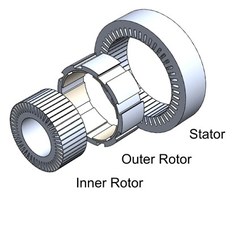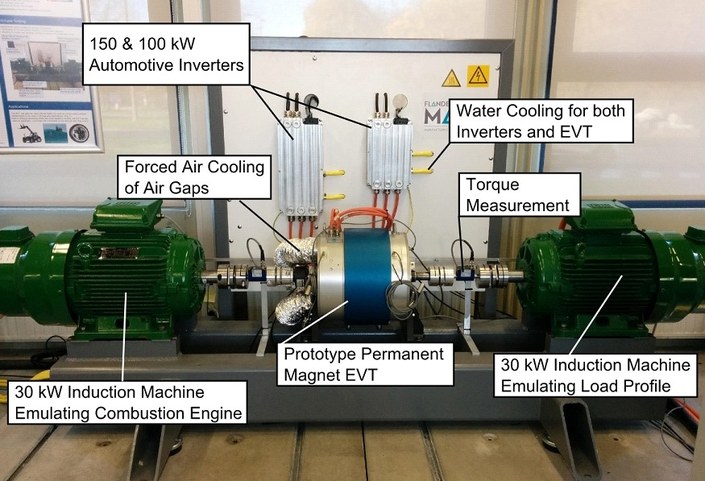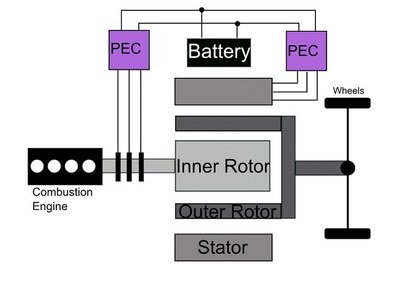Electrical Variable Transmission
Can you imagine the range of applications for a transmission without gliding or sliding contact surfaces, a transmission which is moreover continuously variable in an electrical manner? UGent has been studying such an Electrical Variable Transmission (EVT) system in much detail for some time now. A test set-up including such an EVT has been created and the added value for different applications was studied in the Flanders Make SBO project EMTECHNO.
What is an EVT?
An electrical variable transmission or EVT is a fully electromagnetic continuously variable transmission which provides two additional electrical ports for hybrid functionality. Topologically it can be seen as an electric machine with two concentric rotors. The inner rotor contains three phase windings and slip rings to transfer electric current to these windings. The outer rotor can be a squirrel – cage rotor, or can contain permanent magnets depending on the type used. The stator finally is a conventional electric motor stator. Today, very few such devices exist, but one has been developed in the past by Electrical Variable Transmission BV and has recently been adopted in a unique test setup at Ghent University.

Typical application
A typical application is in the drive train of a vehicle. In that case mechanically one of the shafts is connected to the internal combustion engine (ICE), the second shaft to the final drive of the vehicle. Electrically both the stator and the inner rotor are connected to a common dc-bus using two power electronic converters (PEC’s). Optionally a battery can be added. The main functionality of the EVT is to work as power split transmission. The power to the wheels is split in a part coming from the ICE, while the remaining part is exchanged with a battery. A drive train with EVT is thus a hybrid drive train. When the battery is omitted, the EVT can work as a “simple” continuously variable transmission (CVT).
Advantages
Using an EVT results in additional advantages over other hybrid drive trains. The EVT combines several functionalities into a single device, making the system compact. The EVT is expected to have a higher efficiency. There is no need for lubrication, sealing or valves. Except for the slip rings, the system is maintenance free. Since there is no mechanical connection between the ICE and the wheels, the EVT provides an inherent overload protection, and can also actively damp vibrations. There is a high power DC-bus for external power take off inherently present allowing for easy exchange of electrical power. The EVT can be used as electromagnetic retarder, storing the kinetic or potential energy in the battery.
Other applications
The EVT can also be used in other applications, some of which will be studied in the project EMTECHNO (*). E.g. in energy harvesting applications where the power source has a strongly variable speed, the EVT can be used as special generator to provide a constant power to the grid. The EVT can also be used as a more efficient replacement for a hydraulic torque converter in off-road applications. The variability of the transmission can also be used to drive electrical machines in manufacturing machines in a more intelligent and energy efficient manner.
Research at UGent
The research at the electrical energy department of UGent focuses on both the component level (electromagnetic, thermal and mechanical) as the subsystem level (torque control, efficiency, power density). An experimental setup of the permanent magnet EVT is located at Technologiepark 131, Zwijnaarde, Belgium. The goal is to verify the analytical and finite element derivations. Both efficiency measurements and dynamical analyses are being performed at this moment. 
Contact:
For more information:
Peter.Sergeant@UGent.be
www.eedt.ugent.be
(*) EMTECHNO is a Flanders Make SBO project initiated by the VD1 department of Flanders Make ‘Power Electronics, Actuators and Storage’. It is part of the realization of the research priority ‘Clean and Energy Efficient Motion Systems’.
